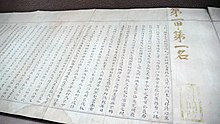Zhuangyuan
| Zhuangyuan | |||||||||||
|---|---|---|---|---|---|---|---|---|---|---|---|
 Imperial exam paper of Ming dynasty Zhuangyuan Zhao Bing-zhong in 1598 AD | |||||||||||
| Chinese name | |||||||||||
| Traditional Chinese | 狀元 | ||||||||||
| Simplified Chinese | 状元 | ||||||||||
| Hanyu Pinyin | zhuàngyuán | ||||||||||
| |||||||||||
| Vietnamese name | |||||||||||
| Vietnamese alphabet | trạng nguyên | ||||||||||
| Chữ Hán | 狀元 | ||||||||||
Zhuangyuan, or trạng nguyên in Vietnamese, variously translated into English as principal graduate, primus, or optimus,[1] was the title given to the scholar who achieved the highest score on highest level of the Imperial examination, 省試 (in the Tang dynasty) and 殿試 (in the Song dynasty)[2] in ancient China and Vietnam.
In China, Fu Shanxiang is known as the first (and last) female zhuangyuan (nü zhuangyuan) in Chinese history, but under the Taiping Heavenly Kingdom, not the regular imperial exams. After the Taipings captured the city of Nanjing, they offered an exam for women in January 1853 in which Fu attained the highest score.[3]
In Vietnam, the first de facto trạng nguyên was Lê Văn Thịnh, a Lý dynasty scholar. He was the chief negotiator who persuaded the Song to return the 6 districts of Quảng Nguyên (today Hà Giang province) to Vietnam. Nevertheless, the first Vietnamese person to be trạng nguyên was in fact Khương Công Phụ under Chinese Tang Dynasty. The first female trạng nguyên (nữ trạng nguyên) was Nguyễn Thị Duệ, who later become a consort of the Mạc Emperor Mạc Kính Cung. She had previously been a consort of the Lê Emperor Lê Thần Tông, and would serve as an official in the Revival Lê dynasty after the fall of the Mạc dynasty.[citation needed] Under Nguyễn Dynasty, the title trạng nguyên was not officially abolished, yet its standards were too high that it was virtually unachievable.[4]
In China[edit]
In total, there were 596 zhuangyuan in ancient China.[5]
Noteworthy zhuangyuan[edit]
- Chen Wenlong
- Weng Tonghe
- Hong Jun
- Fu Shanxiang, Taiping Heavenly Kingdom, the first and only woman to become a zhuangyuan
- Mo Xuanqing, was the youngest Zhuangyuan in the imperial examinations during the Tang dynasty
- Sun Fujia, (zh:孫伏伽 (?-658), Tang dynasty dali qing (chamberlain of the Court of Judicial Review), highly regarded for his candid advice to Gaozu and Taizong, the first zhuangyuan in history.
- Tang Gao, became the Zhuangyuan in the ninth year (1514) of the Zhengde Emperor's reign during the Ming dynasty
- Wen Tianxiang, was a scholar-general in the last years of the Southern Song dynasty. For his resistance to Kublai Khan's invasion of the Song, and for his refusal to yield to the Yuan dynasty despite being captured and tortured
- Yu Minzhong, who served as chief grand councilor for part of the reign of the Qianlong Emperor of Qing dynasty.
- Lin Hongnian
- Zhang Sanjia (zh:張三甲 (1876–1898), Qing dynasty), the last military zhuangyuan in Chinese history.
- Liu Chunlin (zh:劉春霖 (1872–1942), Qing dynasty), the last zhuangyuan in Chinese history.
- Xu Shilin, a mythological figure who attained the Zhuangyuan, demonstrated great filial piety to his mother, Bai Suzhen, a white snake spirit imprisoned under Leifeng Pagoda.
In Vietnam[edit]
In total, there were 56 trạng nguyên in ancient Vietnam.[citation needed]
Noteworthy Trạng nguyên[edit]
- Lê Văn Thịnh (黎文盛, 1038 – 1096), the first de facto trạng nguyên of Vietnam's independent era.
- Huyền Quang(玄光, 1254-1334), real name Lý Tải Đạo, a politician and later Buddhist monk who lived during the reign of Emperor Trần Nhân Tông during the Trần dynasty. He was considered to be equal with the first six patriarchs of the Zen Buddhist tradition.
- Nguyễn Hiền (阮賢, 1234-1256), the youngest to become a trạng nguyên at 13 years old, later died at 21 years old. He also many times become an envoy to meet the Yuan dynasty
- Mạc Đĩnh Chi (莫挺之,1272–1346) a scholar and envoy who served three emperors of the Trần dynasty, as well as the ancestor of the emperor Mạc Thái Tổ.
- Nguyễn Trực (阮直, 1417–1474), the first trạng nguyên of Later Lê dynasty
- Phạm Đôn Lễ (范敦禮, 1457–1531), also known as "Trạng Chiếu" (trạng of segde mats).
- Lương Thế Vinh (梁世榮, 1441–1496) a mathematician, Buddhist and poet who lived during Lê Thánh Tông's reign.
- Nguyễn Bỉnh Khiêm (阮秉謙, 1491–1585) a trạng nguyên under Mạc dynasty, known for the ability to predict future.
- Nguyễn Thị Duệ (阮氏叡, 1574-1654), the first and only female trạng nguyên.
- Nguyễn Đăng Đạo (阮登道, 1651–1719), a tể tướng (Grand Chancellor) under Later Lê Dynasty.
- Trịnh Tuệ (鄭橞; 1701–?), the last person to achieve the title trạng nguyên.
- Phan Đình Phùng (潘廷逢, 1847–1896), a revolutionary against French colonialism.
- Nguyễn Phong Di, the last de facto trạng nguyên of Vietnam.
In modern culture[edit]
In modern Chinese, zhuangyuan is used to refer to anyone who achieves the highest mark on a test, or, more generally, to anyone who is at the forefront of his or her field.[6] In mainland China, the term is most often used to refer to the highest score at the provincial level for either the social sciences (文科) or physical sciences (理科) track of the annual gaokao college entrance exam.
See also[edit]
- Imperial examination
- Confucian court examination system in Vietnam
- Jinshi (imperial examination)
- Bangyan (Bảng nhãn, 榜眼)
- Valedictorian
References[edit]
- ^ *Hucker, Charles O. (1985). Dictionary of Official Titles of Imperial China. Stanford: Stanford University Press. p. 187.
- ^ 萧源锦,《狀元史話》,重庆出版社,1992,ISBN 7-5366-1648-1
- ^ Mao (1998), p. 43.
- ^ "Triều Nguyễn có đặt ra lệ "Bất lập Trạng Nguyên" không?". 23 November 2017.
- ^ 萧源锦,《狀元史話》,重庆出版社,1992,ISBN 7-5366-1648-1
- ^ 《现代汉语词典》,商务印书馆,第五版,ISBN 7-100-04385-9
Further reading[edit]
- Mao, Jiaqi (Grace Chor Yi Wong tr.) (1998), "Fu Shanxiang", in Ho, Clara Wing-chug (ed.), Biographical Dictionary of Chinese Women, Armonk, NY: Sharpe, pp. 43–45, ISBN 0765600439
